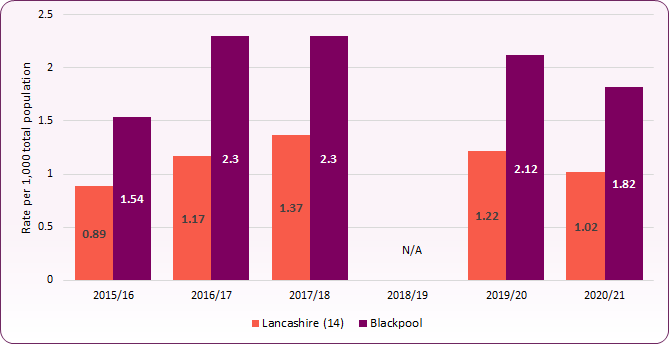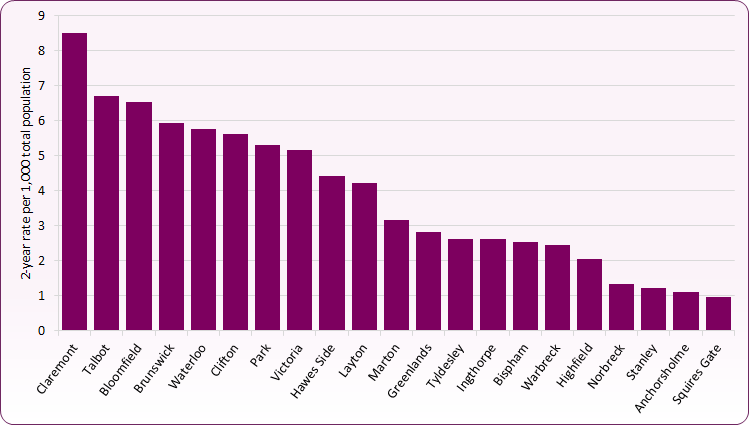Child Sexual Assault
Last Modified 15/04/2022 10:53:58
Share this page
Introduction
What is Childhood Sexual Assault?
Sexual assault should be distinguished from Child Sexual Exploitation (CSE), although there may be overlap, as victims of CSE are at higher risk of sexual assault. The ONS defines sexual assault as either1:
-
- “Sexual assault by penetration.” This is defined as attempted or actual penetration of the mouth, vagina or anus with a penis, an object or the assailant’s fingers.
- “Other sexual assaults, including indecent exposure or unwanted touching”1
Statistics outlining sexual assaults brought to the attention of the authorities, including the police and social services, are available, but remain limited by under-reporting.
Risk factors for Sexual Assault
Children and young people under 16 are at greater risk of sexual assault if:
-
- They are female. The ONS found 11% of females had been sexually assaulted in childhood, compared with 4% of men.1
- They are gay or bisexual. Gay and bisexual adults were more likely to report childhood sexual abuse than heterosexuals. However, for non-penetration assaults, this difference did not reach statistical significance.1
- They are white, or have mixed multiple ethnicity. The ONS found that those who self-reported being White or of mixed ethnicity were more likely to report experiencing sexual assault in childhood (20% and 24% respectively) than those who described themselves as Asian (11%), Black (15%) or another ethnicity (11%). Some organisations have suggested differences in reporting regarding assault and CSE may be an artefact related to varying degrees of reporting between ethnic groups.1
- They have a disability. 11.5% of adults describing themselves as having a disability or long-term illness reported childhood sexual assaults, compared with 5.8% who had not experienced these difficulties.1,2,3
- They are looked after/in care. A recent report from Public Health England establishes that young people in care are more likely to have experienced sexual assault.4
- They have been dispersed by conflict, especially if unaccompanied by adults.4
Who commits Sexual Assaults?
-
- Most children are assaulted by adults known to them. Barnado’s has estimated that fewer than 10% are assaulted by strangers.5
- Whilst children are more likely to be sexually assaulted by family, friends or acquaintances, more than 40% of adult abuse survivors reported they had been assaulted by a stranger. In other forms of abuse, strangers were the least likely to be reported as abusers.1
- An ONS report establishes boys are more likely to be sexually assaulted by someone “in a position of trust (such as teacher, doctor, carer, youth worker”) than girls.1,6
Signs that a young person may have been sexually assaulted
Signs that a child or young person may have been sexually assaulted have much in common with other forms of sexual abuse. They include:
-
- Evidence of physical assault, including bruising7
- Symptoms suggestive of depression or anxiety, including withdrawal; altered appetite; and reduced attention to self-care7
- Falling academic performance7
- Self-harming behaviour7
- Alcohol or substance abuse7
- Inappropriately sexualised behaviour6
- Somatic symptoms including abdominal pain, altered menstruation and gastrointestinal discomfort6
The WHO report also emphasises that there may be no evidence of sexual assault.6 The reliance on retrospective data from adult survivors of sexual abuse also emphasises that the problem is widely under-reported, as victims may not disclose assault for many years.1
Facts and figures
Information from Safer Lancashire show sexual offences make up approximately 3 in every 100 crimes across Lancashire8.
- There were 641 sexual offence crimes recorded in Blackpool in COVID-19 affected 2020/21
- This was a decrease of 11.7% from 726 offences in 2019/20 and an 18% decrease from 783 offences in 2018/19
- The 2020/21 sexual offence crime rate in Blackpool (4.63 per 1,000 population) is 80% higher than the overall Lancashire rate (2.54 per 1,000).
- 39% of sexual offences in Blackpool involed children (similar to Lancashire at 40%)
- In 2020/21 there were 252 sexual offences on children aged under 16 years in Blackpool at a rate of 1.82 per 1,000 total population (compared to 1.02 per 1,000 across Lancashire). In 2019/20 there were 294 sexual offences involving children under 16 at a rate of 2.12 per 1,000 ( compared to 1.22 per 1,000 across Lancashire).
Figure 1 shows the trend in the rate of of sexual offences against children under 16 years of age and compares Blackpool with the Lancashire average. The rate in Blackpool is significantly higher than Lancashire, though annual rise and falls are reflected across both areas.
Figure 1: Sexual offences against children aged under 16, rate per 1,000 population, Blackpool and Lancashire

Source: Safer Lancashire MADE database, CORA v17. Note: 2018/19 data not available. Within Blackpool there is also wide variation across different wards. Figure 2 shows the average rate per year of sexual offences against under 16s based on combined statistics from April 2019 to March 2021. Rates in Claremont, Talbot, Bloomfield and Brunswick wards are significantly higher than the overall Blackpool 2-year rate of 3.86 per 1,000.
Figure 2: Sexual offences against children aged under 16 across Blackpool wards, rate per 1,000 population, 2019/20 and 2020/21 (2 years combined)

Source: Safer Lancashire MADE database
[] ONS, Abuse during childhood: Findings from the Crime Survey for England and Wales, year ending March 2016 4th August 2016 [Accessed 7th July 2017]
[] Wissink IB, van Vught E, Moonen X et al. Sexual abuse involving children with an intellectual disability: a narrative review. Research in Developmental disabilities 2015;36: 20-35
[] Mueller-Johnson K, Eisner MP and Obsuth I. Sexual victimization of youth with a physical disability: an examination of prevalence rates, and risk and protective factors. Journal of Interpersonal Violence 2014;29(17): 3180-206.
[] PHE, Child sexual exploitation: How public health can support prevention and intervention Literature search to identify the latest international research about effective interventions to prevent child sexual abuse and child sexual exploitation. July 2017.[Accessed 21st August 2017]
[] Barnado’s. Sexual Abuse [Accessed 21st August 2017]
[] WHO. Chapter 7 - Child Sexual Abuse: Guidelines for Medico-legal care for victims of sexual violence, 2017 [Accessed 21st August 2017]
[] RAINN. Warning signs for Teens [Accessed 21st August 2017]
[] Safer Lancashire MADE Dataset, CORA v17, Dec 2017